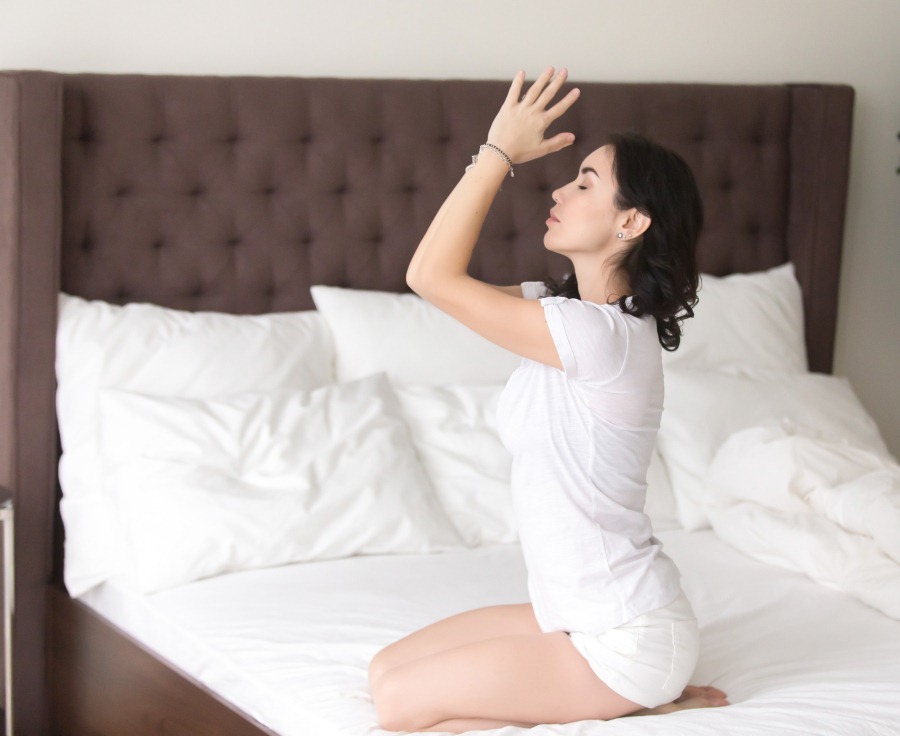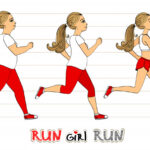This post may contain affiliate links. Please read our disclosure for more info.
Embark on a journey to tranquil sleep with these 6 soothing yoga poses…
If the quest for a restful night’s sleep often keeps you tossing and turning, you’re not alone. This guide might just be the remedy you’ve been seeking.
We’re well aware of the havoc wreaked by a lack of sleep on our bodies.
Sleep deprivation isn’t just a minor inconvenience; it can lead to a cascade of health issues, potentially turning into a life-threatening concern. This underscores the critical role sleep plays in recharging our bodies.
Nightly, our bodies engage in cellular repair, a crucial process for self-healing. This nightly rejuvenation ensures you wake up each morning with renewed energy.
While there are various methods to enhance sleep quality, here’s a gem to consider – yoga. It stands out as a powerful tool that can address multiple sleep-related concerns, from insomnia to irregular sleep patterns.
For a lasting solution to insomnia, incorporate the following yoga sequence into your pre-sleep routine, and let your muscles unwind.
Wishing you peaceful nights of deep sleep!
1. Leg Up The Wall: 2-Minute
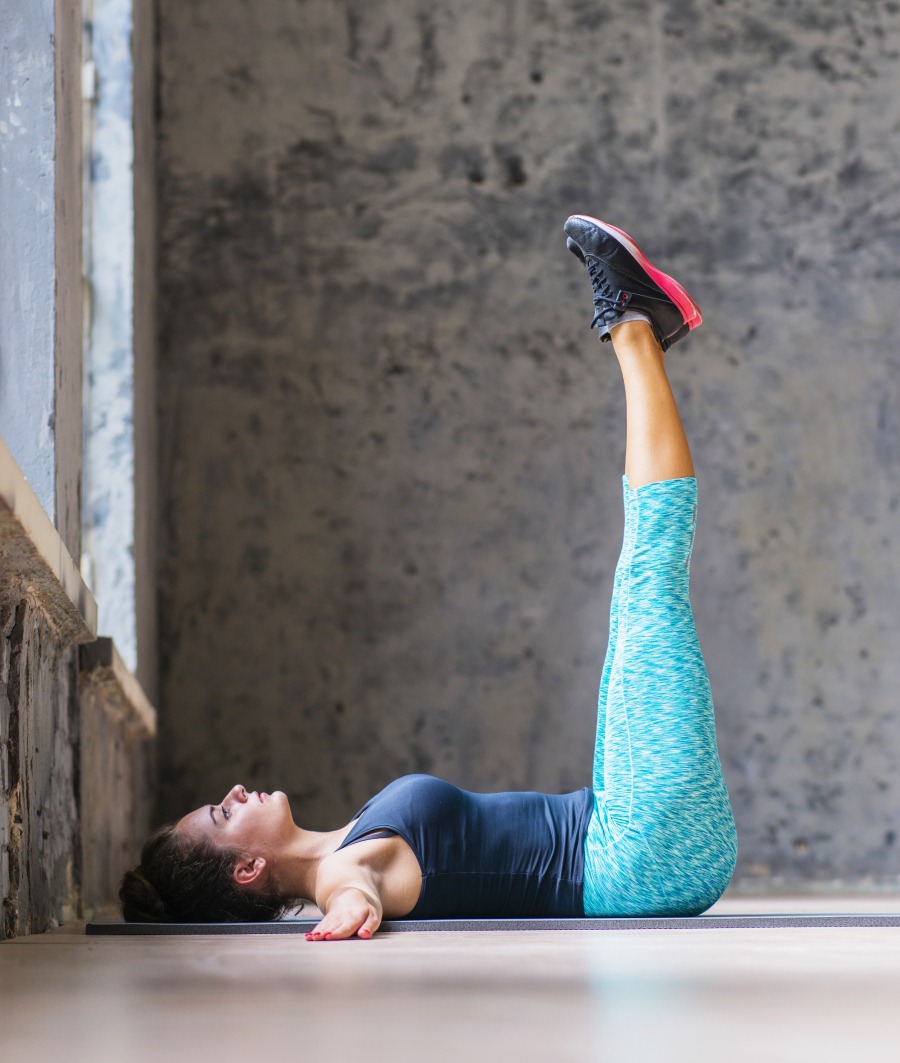
This simple yet potent yoga pose swiftly ushers in a good night’s sleep. Often considered a restorative pose, it profoundly relaxes your muscles, guiding your body into a state of deep rest.
Make it a nightly ritual before bedtime or when sleep proves elusive in the wee hours. Introduce gentle breathing to enhance its effectiveness.
Benefits: Stress relief, better sleep induction, enhanced blood circulation, relief for swollen or cramped feet, menopausal relaxation, hamstring and lower back stretch.
Breathing Tips: Deepen the calming effects by focusing on your breath. Inhale and exhale slowly, maintaining equal breath lengths to create a balance, smoothing the mind’s fluctuations into stillness.
Contradictions: Pregnant women and individuals with glaucoma, high blood pressure, or severe neck and spine issues should exercise caution or seek medical advice.
Easy Tip: Avoid a full 90-degree angle to prevent circulation impediment. Instead, slide your hips a few inches away from the wall.
2. Cow-Cat Relaxation: 2-Minute

Cat-Cow offers a delightful way to gently warm up your spine and back muscles. This accessible yoga pose is perfect for practicing in bed.
This gentle stretch soothes your muscles, spine, and digestive organs, paving the way for a restful night’s sleep. It also promotes healthy blood circulation.
Benefits: Posture and balance improvement, enhanced coordination, stimulation of abdominal organs, stress relief, muscle relaxation, better sleep induction, and gentle spine stretching.
Breathing Tips: Inhale as you arch your back, lifting your head and tailbone for the cow pose. Exhale as you round your spine towards the ceiling, tucking your tailbone and chin for the cat pose.
Contradictions: Individuals with weak wrists and knees should avoid this pose. Pregnant women should consult their doctors for guidance.
You can also try these ayurvedic ways for sleping fast.
3. Child Pose: 2-Minute

A foundational pose often learned at the onset of a yoga journey, the Child Pose, though seemingly simple, goes beyond stretching. Bowing down, resting your head on the floor, and surrendering to gravity create a shape that induces profound relaxation in both body and mind.
While simple, this pose demands patience and an ability to let go, allowing a state of non-doing to prevail.
Benefits: Calming for the mind, digestive tract health improvement, hip opening, muscle relaxation, and promotion of deep sleep.
Breathing Tips: Incorporate slow and deep breaths during this pose. Slow inhalation and exhalation lengthen your breath, narrowing the vital forces toward Sushumna Nadi. This, in turn, directs subtle energy through the body.
Contradictions: High blood pressure patients should avoid this asana. Also, steer clear if dealing with diarrhea or knee injuries.
Easy Tips: If placing your head directly on the floor feels challenging, use a pillow for added comfort.
4. Winding Down Twist: 1-Minute
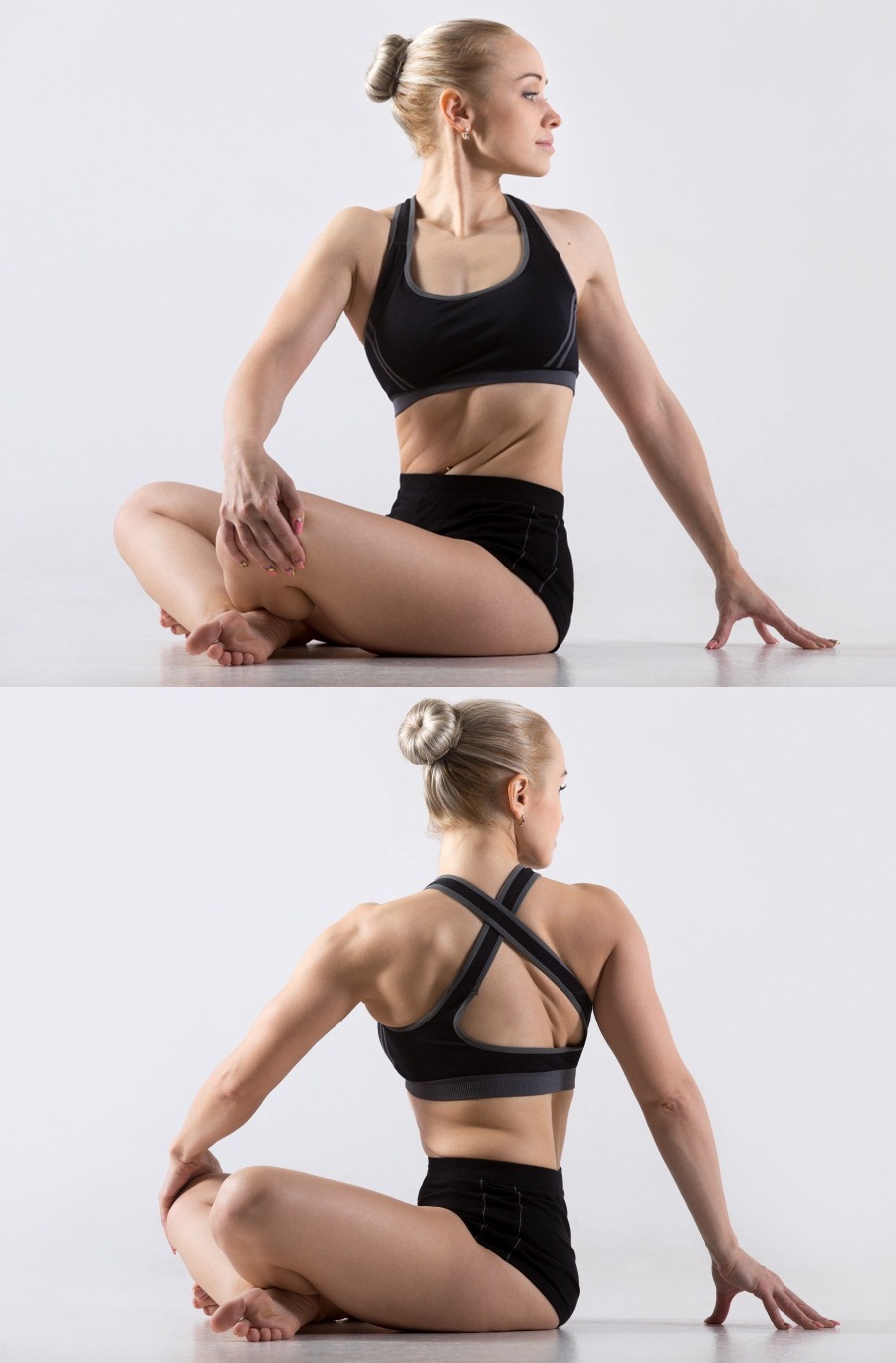
Beyond enhancing spinal flexibility, twisting your body reaps numerous health benefits. Torso twists around the spine compress and massage abdominal organs, including the digestive tract. This pressure expels stagnant blood and toxins from organs like the kidneys, liver, and spleen. Upon release, these organs receive a fresh supply of blood, invigorating digestion and metabolism, promoting restful sleep.
Benefits: Improved spine, shoulder, and chest flexibility, stress and anxiety reduction, stimulation of abdominal organs, energy boost, mental quietude, detoxification support, and relaxation for better sleep.
Breathing Tips: Inhale deeply while twisting and exhale upon returning to the center. Repeat this process several times.
Contradictions: Avoid this pose if you have a knee injury. Those with tight hips can practice a modified version until flexibility is gained. Always respect your limits and, if needed, consult with a healthcare professional.
Easy Tips: If tight hips pose a challenge, try this pose seated on a block or comfortable bedding. Consistent practice will gradually open up your hips and align your spine correctly.
5. Butterfly: 1-Minute
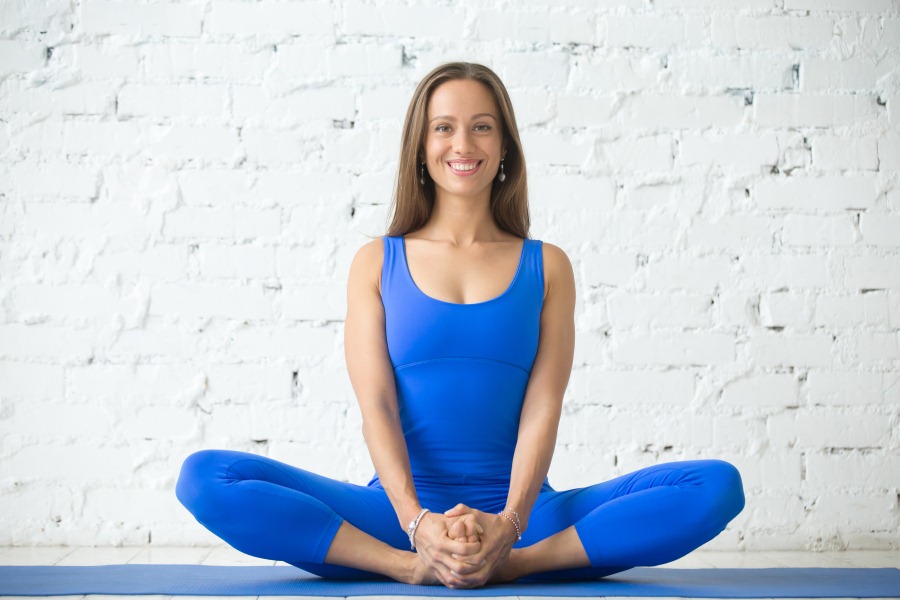
The Butterfly pose involves gentle movement of your knees, mimicking the wings of a butterfly.
This user-friendly yoga pose doesn’t require the guidance of an instructor; you can easily practice it on your own. Particularly beneficial for those who spend long hours on their feet, the pose provides relaxation to thigh and leg muscles through a soothing massage.
Benefits:
- Relax and stretch thigh muscles
- Alleviate pain from prolonged standing and walking
- Relieve stress and tiredness
- Stimulate reproductive and digestive organs
- Eases discomfort and pain during menstruation
- Opens up hips and thigh muscles
- Helpful for pregnant women, easing pain during natural birth.
Breathing Tips: Harmonize your breath with the movement—inhale deeply as you bring your knees closer to the floor, exhale as you raise your knees upward.
Contradictions: Avoid if you’ve recently suffered an injury or undergone surgery. Individuals with pre-existing medical conditions should consult a doctor or yoga expert before starting.
6. Corpse Pose: 2-Minute
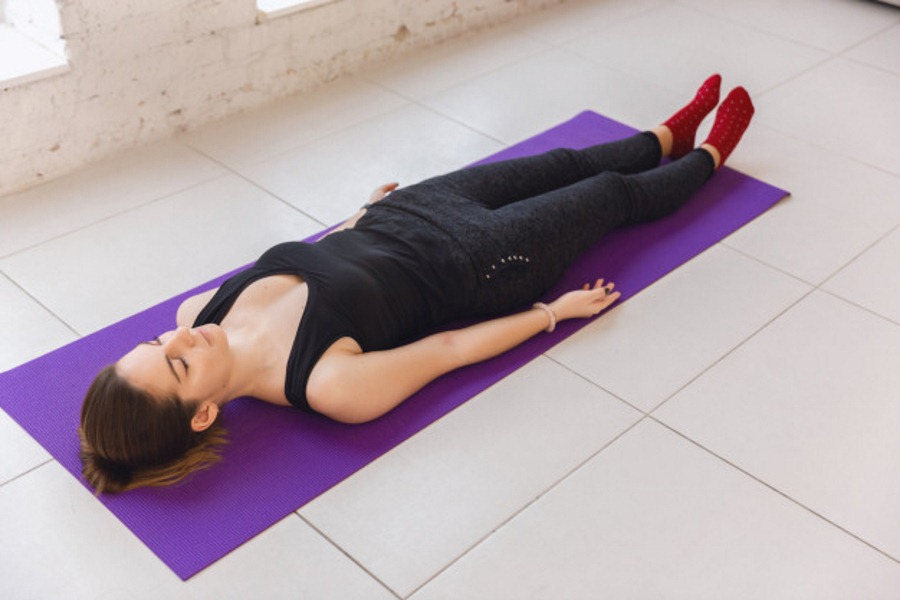
A beloved pose, Corpse Pose, or Savasana, is one of the simplest and most cherished yoga poses.
Often referred to as the “death pose,” it requires no physical strength or movement. Instead, it challenges the mind and body in different ways, emphasizing awareness and curiosity about the body’s natural breathing pattern.
Performed at the end of a yoga session, Savasana serves to calm your muscles.
Benefits:
- Relaxation of the body
- Increased body awareness
- Calming of the mind
- Stress and anxiety reduction
- Lowering of blood pressure
- Headache relief
- Improvement of sleep quality.
Breathing Tips: Breathe naturally to induce a state of calm.
Easy Tips: “Let Go Everything” is the mantra for this pose. Relax your eyes, jaw, belly, and every part of your body. Slowly, this pose guides you into a deep state of relaxation, promoting better and faster sleep.
More Tips to Induce a Good Night’s Sleep
Ensure a restful night’s sleep with these additional helpful tips:
- Avoid Stimulating Content: Refrain from watching horror shows or television just before bedtime, as it may interrupt your sleep.
- Soothing Music: Listen to soft instrumental music, such as mantra chanting or calming tunes, to create a peaceful atmosphere before sleep.
- Mind the Meal Gap: Maintain a gap of at least 2 hours between your last meal and bedtime to aid digestion and prevent discomfort.
- Resolve Conflicts: If you’ve had a disagreement with your partner or loved one, make an effort to resolve it before bedtime for a more relaxed and peaceful sleep.
- Yoga Nidra: Consider practicing Yoga Nidra before sleep, a guided meditation that promotes relaxation and enhances the quality of your sleep.
Remember, while yoga contributes to the development of a healthy body and mind, it is not a substitute for medical treatment. It is crucial to learn and practice yoga under the guidance of a qualified instructor or after consulting with a healthcare professional, especially if you are on medication.

